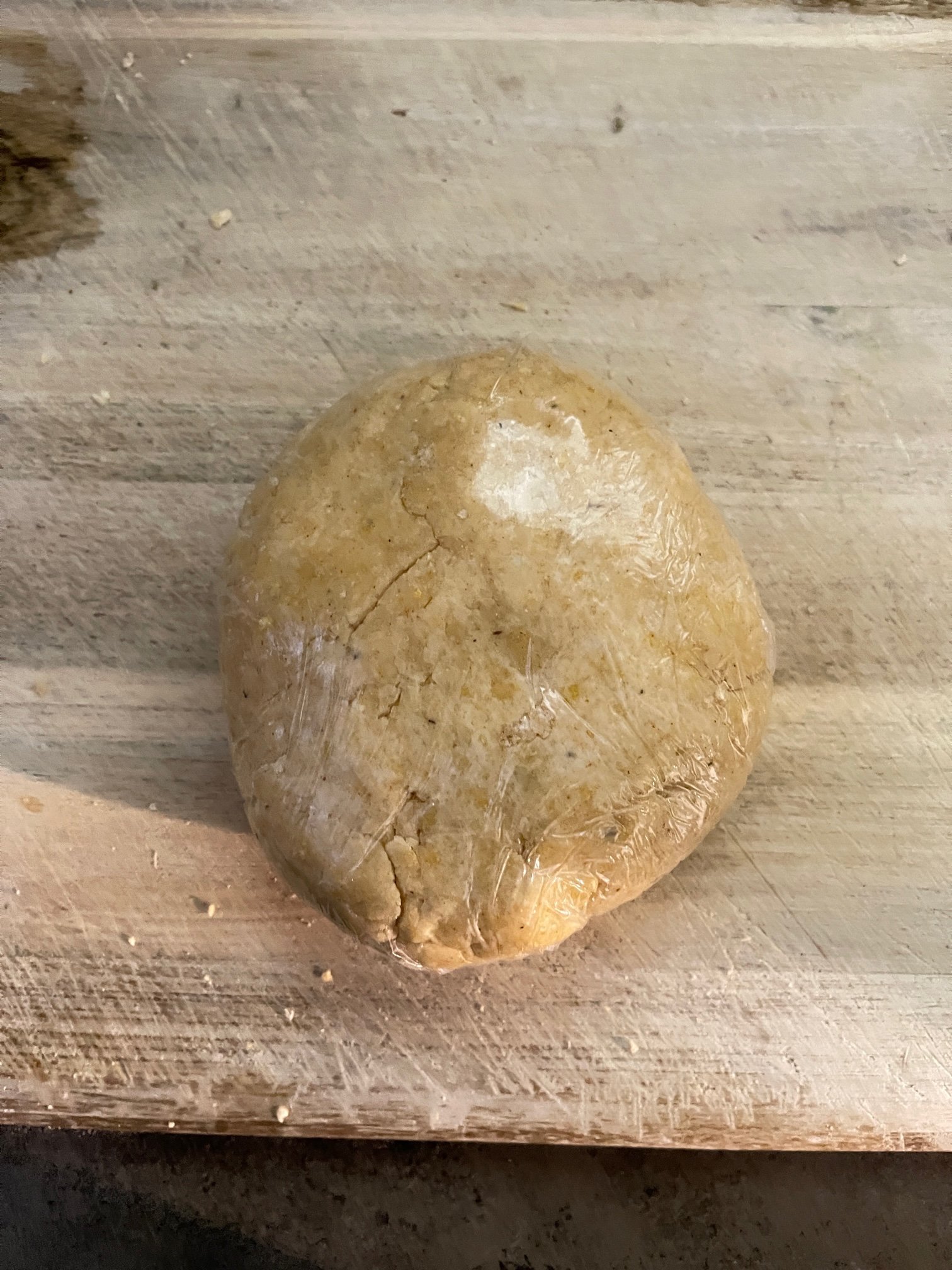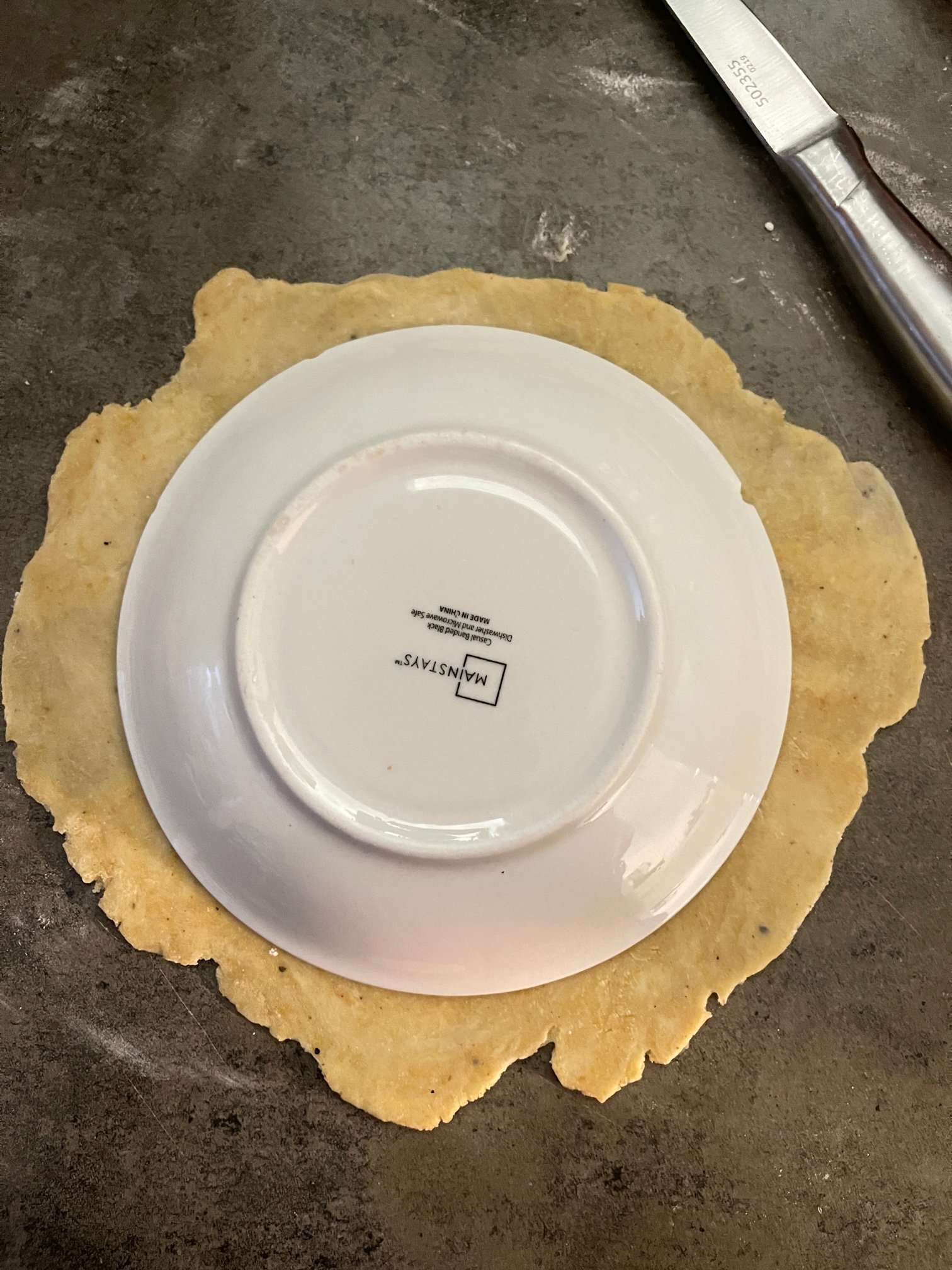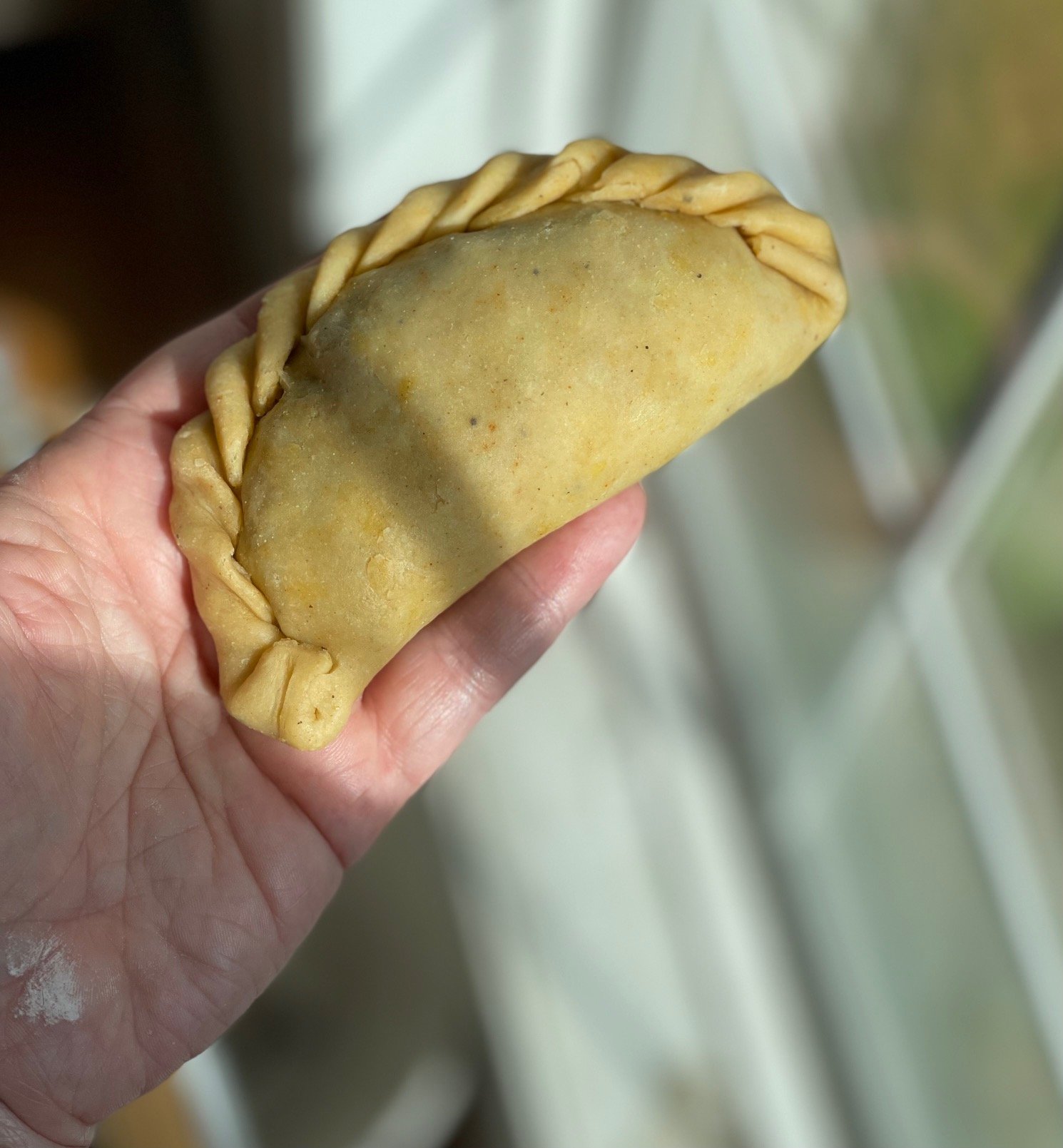Savory empanada dough
As promised, this week’s recipe is empanada dough. Last week’s empanada test, a sore memory to me now, was made correct by omitting the leaf lard I was so insistent on using and replacing it with butter. I sometimes am trying to do too much or be too extra in the attempt to make the recipes unique, but when I fuck up in the kitchen it becomes a good reminder to me that I certainly don’t have to reinvent any wheels here. I am only trying to help you eat well.
Masa, my beloved ingredient, makes an appearance. I reduced the amount by about half in this final test because I wanted mostly AP flour for structure, with the masa coming in for the slightest corn flavor and a bonus of bringing a bit of color to the dough. If masa isn’t a pantry staple for you, feel free to use all AP flour, bringing the total amount in volume to about 2 ½ cups, or 300 grams in weight. There is a half teaspoon of paprika and black pepper in the dough, two things I usually include in savory pastry, but they are optional. We dice the aforementioned butter into roughly ¼-inch cubes, while the egg is there of course to aid in holding everything together, as well as making the dough pliable for rolling out.
I highly encourage you to use a food processor to make the dough and here is why: it will come together beautifully and quickly in about 3 minutes, if that. Maybe you are as tired as I am and this is enticing to you. If you do not have a food processor or just don’t feel like using it though, cut the butter into the dough with your fingers or a pastry cutter until it resembles coarse crumbs. Add in the egg and stir with a fork or your fingers before drizzling in the cold water and kneading in the mixing bowl until the dough comes together.
There are a number of ways to form the dough into empanada rounds. For the first test I used a tortilla press, which mysteriously and annoyingly didn’t get the dough as thin as I wanted, leading to an under-baked empanada center when the outside was perfectly baked. A headache. I found that rolling out each portion of the dough (about 70 grams each for a yield of 8 empanadas) worked best for me. Don’t feel confined to this method though—you can also divide the dough in half after chilling and resting on your counter, roll out each half as wide and thin as you can without tearing the dough, then use a cutter (in my case, a 6-inch dessert plate) to cut out about 4 rounds, then roll out the other half and repeat. I just found it easier for me and my limited counter space to roll out and work with portions of the dough at a time. If when you set the plate or other cutter on the portion of dough you just rolled out and it baaarely fits, that's okay! We are not aiming for perfection, just a round-enough portion of dough with which to build an empanada. The dough has a tendency to stick, so do be sure to flour your work surface. Brush off any excess flour after assembling the empanadas with your fingers or a pastry brush.
This dough is meant to be baked; I did not test frying. As for the filling, you can really feel free to load up your empanada. Be fearless but gentle when folding the dough up and over the filling, it really isn’t prone to tearing as long as you’re not being careless with it. That all-purpose flour and single large egg comes in clutch for the dough! A good, heaping 2 tablespoons of filling works best for this size empanada; you can use whatever filling you prefer as long as it isn’t too liquidy. Sometimes with empanadas there will be a big gap between the filling and the dough after baking and one way to avoid this is to spoon the filling so it has some height, just as much height as width.
It’s also best to use a filling that won’t have any chance under the sun of leaking out of your empanadas. A mixture of pan-fried diced potatoes, roasted and diced poblano and Monterey Jack cheese is what I used here. I used a navy bean and poblano filling that was too brothy for the second test and opening my oven door to a mess of bean spillage on my baking sheet made me literally shriek. Let me help you avoid that. For this amount of dough, you will need about 2 - 2 ½ cups of filling. Two 15-ounce cans of beans would give you roughly 2 ½ cups, if you’re wanting to use a bean filling.
I found that letting the assembled and filled empanadas chill for a bit in the fridge before baking helped the crimped or folded edges to keep shape, which means the empanada will stay safely sealed. I got away with a mere 30 minutes of chill time for this last test, but you could go longer if you’re wanting to make them ahead. You can also make the empanada rounds ahead of time: after rolling and cutting out the rounds, stack each in between small sheets of parchment, then cover in an airtight container or a plastic storage bag and set in your fridge for a couple of days, or in your freezer if you’re wanting to make them at a later date. (No need to bring assembled empanadas to room temperature before baking.) Brush on an egg wash right before they go into the oven at 400F for 30 minutes, and then after that you’re only about 5 minutes away from eating flavorful empanadas. A short video to show how I fill and fold the empanadas is coming later today!
Because I love you, a few filling ideas:
- Picadillo, which is classic. I'd say to just drain any excess fat from the meat before using it as a filling.
- Mushroom tinga, perhaps.
- Refried pinto beans and Oaxaca cheese, my personal fave especially if I add some poblanos to the mixture.
At Heart Panaderia Empanada Dough
Yield: 8 (6-inch) empanada rounds
Prep time: a whopping 5 or so minutes for the dough; cook time varies depending on filling choice
Chill time: 3 hours -12 hours for initial chill; 30 minutes or longer for final chill before baking
270 grams (2 ¼ cups) all-purpose flour
30 grams (¼ cup) masa harina
4 grams (about 1 teaspoon) kosher salt
½ teaspoon paprika, optional
½ teaspoon black pepper, optional
4 ounces (1 stick) cold unsalted butter, cut into small (about ¼-inch) cubes
1 large egg
⅔ cup cold water
Make the dough:
To the bowl of a food processor add the all-purpose flour, masa harina, salt, and seasoning, if using. Drop in the cubed butter and the egg and pulse until it all resembles coarse crumbs. With the processor running, drizzle in the cold water; continue to process until a rough dough forms. Transfer dough to your work surface now and knead just a few times. Wrap the dough with plastic and let it hang out and chill in your fridge for at least 3 hours and up to 12 hours (the longer, the better).
After your dough is done chilling, remove it from the fridge and set it on your counter to soften a bit. If the dough was chilling for 3 hours, it should be ready to divide and roll out in about 30 minutes; if it was chilling for longer, and up to 12 hours the dough will need to sit out for a couple of hours, at least 2, before it’s ready to be divided into portions and rolled out. This is to prevent dreaded cracking in the dough.
Prepare your filling as the dough sits out on your counter. Let the filling cool to the touch before using it in the empanada.
Divide and roll the empanada dough:
Once the dough has softened a bit, it’s ready to roll: Divide the dough into 8 pieces that weigh about 70 grams each. Dust your work surface and rolling pin with a little flour. Take one 70 gram piece of dough and roll it out to a roughly 7-inch round. It’s fine if it’s not a perfect circle since you’ll be cutting out a smaller circle from the dough! It’s more important to roll the dough thin.
Flip a 6-inch round plate on the rolled out portion of dough so the lip edge is touching the dough, then trace the edges of the plate with a paring or butter knife. Lift the plate, then peel away the excess dough to reveal a 6-inch empanada round. (If you don’t have a 6-inch plate, you can use any round food-safe item in your kitchen that comes in at around 6-inches in diameter, such as a cake pan or cookie cutter.) You may have enough dough scraps to make 1-2 additional empanadas.
Spoon 2 heaping tablespoons of your cooled, prepared filling onto one side of the empanada round, making sure to leave a border to seal the empanada. Moisten the edge of the empanada dough closest to you with a little water, just using your finger. Gently fold the side of the dough furthest from you up and over the filling now. Seal the empanada with your fingers by pressing the two edges together firmly.
Assemble the empanadas:
Dab a bit of water again along the border to help seal it further. From here you can easily just use a fork to crimp the edges, or you can watch how I do it in the video if you want a folded edge.
Repeat with the remaining dough. Set each empanada on a dinner plate as you assemble them. It’s fine if they overlap or if you have to stack them on top of one another.
Cover the plate of empanadas with plastic wrap and transfer to your fridge to chill for at least 30 minutes or up to 2 days.
Bake the empanadas:
When ready to bake, set your oven to 400F. Place 4 empanadas on a baking sheet, then brush each with an egg wash and bake for 30 minutes, or until the undersides of each are nicely browned. Move to a cooling rack once finished baking, then repeat with the remaining empanadas. Serve empanadas immediately with roasted poblano and scallion chimichurri, or however you like to serve empanadas. To reheat empanadas: you can microwave it for 60 seconds; alternatively, you can reheat in the oven at 300F for 10 minutes.







